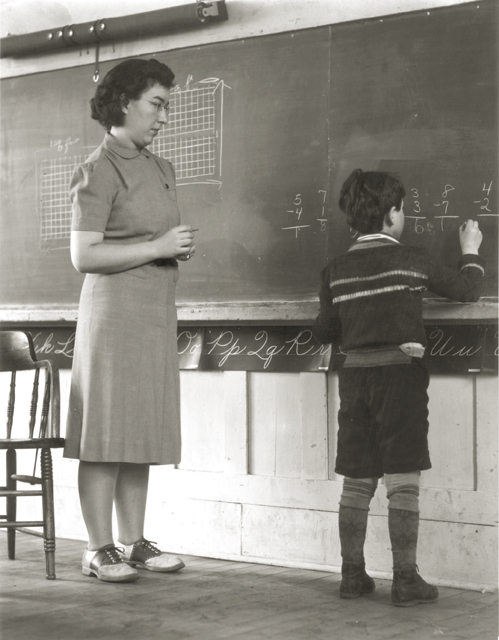Teacher in a Strange Land: Opportunity Knocks and Grade Level Answers the Door
Last month, Ed World was abuzz over a flashy new report from TNTP, the refurbished face of The New Teacher Project. The New Teacher Project was a super-reformy org originally started by Michelle Rhee to promote the idea of placing smart, eager (and also cheap) college grads with superior content knowledge, like Michelle, in needy classrooms, replacing the tired old ineffective dishrag teachers slogging along there.
TNTP has morphed into another grant-funded report-writing nonprofit, surfing the reformy trends and saving the world, one white paper or glossy report at a time. You really need to take a look at the report, because it’s uber-slick, from its title–The Opportunity Myth— to its multi-directional graphics and catchy bullet points.
Its main point: Most students are doing work below grade level. And we should immediately change that, so students can reach their potential, which seems to mean getting into competitive colleges and becoming neuroscientists.
‘That’s the opportunity myth. It means that at every grade level, in every district, for students of every demographic background, school is not honoring their aspirations or setting them up for success—in their next grade, in college, and in whatever they want to do down the road.’
Notice—every grade level, every district, every demographic is currently being failed by… schools, which are not setting them up to succeed. Because ‘schools’ are not giving students grade-level work.
How does TNTP know this? Because they amassed a huge data set—20,000 samples of student work!—from students and teachers in five school districts. That’s right—five districts, including three urban, one rural (where all the white kids were) and one charter district. Anyone who’s ever corrected papers knows that 20,000 pieces of student work could easily be the annual total for two or three secondary math teachers—although it certainly sounds like a big, impressive data number. Extrapolating the numbers from five districts to the entire public education system? That’s a data fail.
Peter Greene does a wonderful job of deconstructing the research and the flabby, well-duh recommendations—which begin with the following statement:
‘We readily acknowledge that we don’t have a detailed operational plan to improve student experiences at scale. But we believe it’s time to…return to the basic guiding principle that brings us to this work: the right of every student to learn what they need to reach their goals. But we think we know where to begin, and it starts with making students’ daily experiences the center of our work.’
That statement is the dead giveaway that the report, research and recommendations were crafted by non-teachers, who were ‘trained’ to compare a daily assignment to what the Common Core (masquerading as ‘College and Career standards’ in this report) says Any Given Student ought to know and be able to do in, say, 5th or 11th grade.
Because—honestly—I don’t know any teacher who doesn’t believe students have a right to pursue high and worthwhile goals. And ‘students’ daily experiences’ are pretty much the entire point of teaching.
The weakest link in the report, however—the core assertion that marks it as just more pearl-clutching sludge– is all the fussing over ‘grade-level’ work.
Some observations:
- As a metric, ‘grade level’ is pretty wobbly. We’re all familiar with the fact that kindergarten is the new first grade, and that national standards have pushed everything from algebra to frog dissection down a level or two, whether students are developmentally ready or not. We have increasing numbers of students whose native tongue is something other than English, policy churn and students moving in and out of schools due to ‘choice.’ What Arne Duncan called ‘the same goalposts’ has never been reality.
- We need to meet students where they are. There’s no point in following college readiness standards and a pacing guide if the students haven’t absorbed today’s lesson or last year’s core content. All those lessons deemed too easy by TNTP might have been exactly what the students needed to move forward.
- In any given class, even in a highly tracked system, there are students at multiple points on the understanding/application spectrum. And in two weeks, most of them will be someplace else. Some will have leapt ahead. Others will be stuck. And some, for some inexplicable reason, will be in retrograde, with skills once mastered having dribbled off. It’s the teacher’s job to give them all something to do, something that will either add new knowledge, provide practice opportunities, or extend their understanding. Planning lessons is the proverbial moving target, a fact that standards creators and those wishing to ‘re-imagine’ school as more uniform seem to have missed.
- The use of student work samples to evaluate instruction means the research analysis—comparing the samples to standards—was based on tangible items: paper-based assignments, artifacts created using computers, and so on. Things. This seems to ignore that fact that lots of valuable student work cannot be photographed and sent digitally to ‘analysts.’ It leaves out many types of assignments and assessment models: discussion, observation, silent reading, role plays, student leadership in group learning, model-making, movement, conversations with a teacher. It leaves out things that cannot be assessed but are critical for learning—imagination and play.
- It’s worth remembering that grade levels (and assigning students to age-similar groups) are arbitrary. And–it’s a journey, not a race. Deciding when to accelerate is a function of experienced judgment on the part of the teacher. I have seen students cover six months’ worth of content in three, once some core ideas took root—and that was in my class made up of students in four so-called grade levels, 9th through 12th
If the purpose of school is giving students tools to pursue their goals, judiciously increasing the difficulty level of their work is only one aspect of successful outcomes. Students need to feel a sense of safety and belonging before the small successes can accrue. Skipping that step is folly. The range of what students learn in school is vast, and much of it is not measurable.
Probably the most irritating aspect of the report was snapshot profiles of individual students, where the report’s authors reveal their background biases. There’s the immigrant girl headed for a career in medicine: Her father wants her to go to college, so she can avoid the kind of suffering he’s experienced working in a local factory. Remember when unionized skilled factory workers were the backbone of the economic growth of the nation—a job that supported a family, not something to be ashamed of?
And then there’s the student who is torn between boredom and frustration. Sometimes, she finishes her work after 20 minutes, and is bored. But sometimes, she doesn’t understand the work and is frustrated. To me, this sounds like a typical kid in a well-functioning school—one where some things are easy and others hard. The kind of kid who carries a paperback to fill time in one class but needs after-school tutoring in another subject.
The TNTP report, however, sympathizes–her teachers, they claim, should be hitting the magic instructional sweet spot, the zone of proximal development, day after day. Each lesson should be just challenging enough to engage interest, but not too difficult. Otherwise, says the report, months will be wasted every year. Return on investment will be inadequate.
And with that, it becomes clear just who’s on the hook here. And just who has never had to deal with the messy, chaotic, non-standardized, glorious, rewarding job of classroom teaching.

This blog post has been shared by permission from the author.
Readers wishing to comment on the content are encouraged to do so via the link to the original post.
Find the original post here:
The views expressed by the blogger are not necessarily those of NEPC.
